There seem to me two essential questions about what to do with this post-Nature nature:
- Will it hurt us?
- Can we love it?
The answer to both questions seems to be yes.
Walking the Newtown Creek Nature Walk on the border of Queens and Brooklyn with the Field Guide provided by the Floating Studio for Dark Ecologies reminds you that moving past “nature” will be disorienting. We need to do it, but it won’t be easy. Some parts of post-naturing seem clear enough: I’m ready to move beyond the pure Romantic green that constructs the nonhuman environment as passive background to human striving and a resource to be exploited. But what are we supposed to do about the brown post-industrial spaces left behind after the end of the green? How do they make us feel? Might they still participate in the great goddess Natura’s creating magic?
Toxic Water
The image that’s stuck with me after my first walk through non-Nature nature was the water. On a warm October afternoon, standing on stone steps that dropped down into the edge of the creek so that the bottom step was covered by three inches of water, I stared down and saw — nothing. The water, famously toxic, lapped the granite steps in transparent placidness. It didn’t look like anything at all. Nothing unnatural to see here.
Even if I’m not going to swim, I like to put my fingers into bodies of water, to get the touch, the smell, sometimes a little taste, especially in a brackish estuary like Newtown Creek. I was careful not to do that this time.
Black mayonnaise
I’m not sure how deep Newtown Creek is at the junction of Whale Creek near the “digester eggs” that process New York’s sewage. But everyone knows what’s on the bottom of these creeks. “Black mayonnaise.” The sludgy remains of decades of coal and oil-fired industry, including in this case the discharge of the 1978 Greenpoint Oil spill, which released into the confined waters of the creek three times as much oil as was released in the Exxon Valdez spill of 1989. Back in the summer of ’89 I was a vagabond college graduate who traveled to Alaska to shovel tar and oil off a beach about 400 miles southwest of the initial site of the spill. In Greenpoint, three times as much oil as would later foul 1300 miles of Alaskan coastline was contained inside two tiny sluggish creeks Little Leaguers could play catch over. There’s a lotta mayo down beneath. The Field Guide says there is a “15-25 feet layer lining Newtown Creek’s bottom…a toxic admixture the consistency of mayonnaise. Oil, arsenic, polychlorinated biphenyls, and incinerated ash are some of the organic and inorganic pollutants that the EPA is quantifying in their Superfund assessment” (5).
I remember the gas station smell of the beach in Windy Bay, Alaska, when we shoveled oil residue into industrial plastic bags in the summer of ’89. I couldn’t smell anything like that on the steps in Newtown Creek. Just a faint salt tinge, carried by a breeze that barely made the surface flutter.
Epochal steps
The steps leading down to the creek fan out like a small amphitheater, asking you to face the creek as if to watch a performance whose dark center you can’t see. Each step has a name inscribed on it. Some are geological epochs: “Jurassic.” Others name local plant species: “Angiosperm.” “Tracheophyta.” These names were inscribed according to the design of environmental sculptor George Trakas when the Nature Walk was built in 2007. Walking down to the water feels like walking down into time, though I suppose it’s more like walking into a post-nature future. What would have happened if I had taken one more wet step?
Hellmouth
The audio tour calls it the hellmouth. The sign above the opening reads: “CAUTION. Wet weather discharge point.” The smell made it clear what was coming out of that mouth into the creek, even though we visited on a dry afternoon.
Fishing
One of the questions the Floating Studio for Dark Ecologies asks of people who have walked through the Creek with their audio tour is, “What did you not expect to see?” There was plenty of life in the post-Nature, including spartina grass and many other healthy-looking plant species. There was plenty of post-natural debris, what the Floating Studio calls “floatables.” We joked that at one point that we thought we saw a dog swimming, but it turned out to be plastic. But the thing we didn’t expect, certainly, was a fisherman.
He was a young hipster-ish local presumably from Greenpoint, casting his line for the same striped bass that my neighbors fish for off the CT shoreline in mid-October. He said he often caught bass in Whale Creek. We watched him cast a few times, with the sci-fi digester eggs visible over his shoulder. I didn’t get a good picture. He didn’t get a fish.
Plastic you can see through
My favorite bit of floating debris was a sheet of semi-translucent plastic that floated on Whale Creek’s still water like a pane of fragile glass. I watched it slowly revolve, an undegradable petrochemical solid resting atop ten or fifteen feet of toxic water, both of them perched above a thick, invisible, omnipresent swamp of oil mayo. Floating is a bit like flying, in that it holds a body just at the top of a larger fluid body. The plastic was doing the thing that I wanted to do but could not do — that is, swimming in post-Nature.
Digester eggs
Installed in 2010 as part of the Wastewater Treatment Plant renovation, these eight “shiny spaceships” light up in the North Brooklyn night. Watching them from across Whale Creek they appeared fantastical. All of us wanted to come back at night to see the purple glow.
These eggs display the techo-aesthetic of industrial environmentalism, a new post-Nature system that takes in about 1.5 million gallons of sludge each day from New York City, processes it with heat, time, and “burping,” and generates carbon dioxide, water, methane, and biosolids. Garbage goes in, and sustenance comes out. Long Island City locals call the array “shit tits.”
Fragrance Garden
The last stop on the audio tour, underneath the stairs that lead up into the path to the water, was a fragrance garden. On our way out of the Nature Walk, we turned beneath the steps and followed a low path through to the garden beneath. We’d seen flowers already on our walk; a Virginia Rose back across from the digester eggs had even quoted Juliet: “That which we call a rose / By any other name would smell as sweet.” A pretty good joke, I thought, given how close the flowers were to the smellmouth.
But the garden beneath the steps was a bizarre under-metal smellword and antidote to the occasional toxic whiff the creek had given off. Shaded by the steps, the fragrance garden provided a respite and conceptual bridge back into Greenpoint.
Twenty minutes later we were at a rooftop bar drinking overpriced cocktails.
Post-natural thoughts —
I went there looking for toxins but found multiplicity.
I was trying to unsee Nature as a unitary object and find post-Nature in networks.
One strange thing: I kept thinking about beauty, and about design. I always think clear water is beautiful, no matter what’s beneath the surface. The plastic floatable bears a semi-translucent charm. What do we want beauty to do for us?
I also thought about one of Marina Zurkow’s phrases about urban ecology and design, that I first heard her describe at the Oceanic New York event at St. John’s in 2013. “Soft edges” are what we need, especially when it’s hard to fit things together. I was thinking about that when looking at the locking-gear design of the creek’s shoreline, the graceful curves of the digester eggs, and the step that was submerged in creek water. Where exactly are the edges?
What I always want in nature is to be porous, to let some bit of the not-human seep into me. To be porous in Newtown Creek, that painfully apt representation of our Anthropocene future, requires us to be both toxic and digesting. We can’t get too close. But we must get close.
I’m going back next week. Maybe at night.
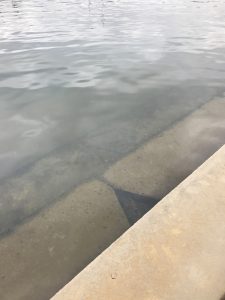
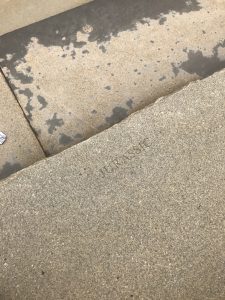
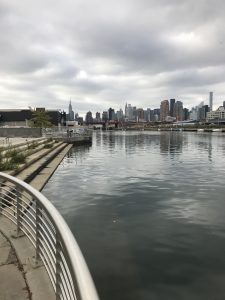
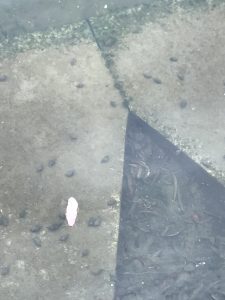
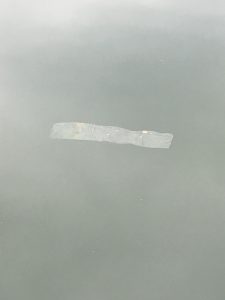
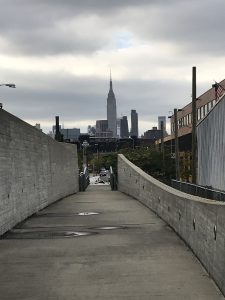
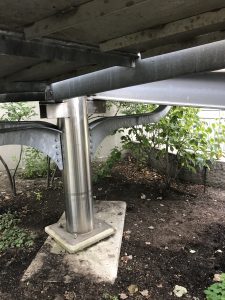
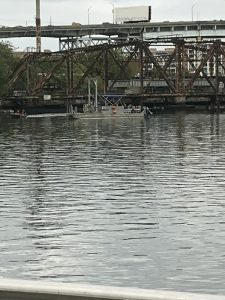
[…] walking my favorite toxic pathway on the borderlands between Greenpoint and Long Island City on the Newtown Creek Nature Walk. I’ve not been back for a while, but all my favorites were there: the epochal steps, the […]